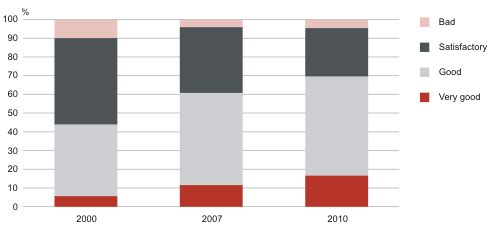Living conditions of households with children have improved during the past decade
In 2010, the condition of the dwelling was satisfactory for every forth household with children; every twentieth household with children lived in bad or even uninhabitable conditions. Compared to 2000, the assessment of the condition of the dwelling has considerably improved. Ten years ago, almost a half of households with children considered their dwelling satisfactory and a tenth of them considered it bad.
Households with children tend to have a better opinion of the condition of the dwelling they occupy than households without children. In 2010, among the households without children, 60% believed their dwelling to be in a good or very good state, a third evaluated it satisfactory and 7% considered it poor. Couples with two children have the highest opinion of the dwelling they occupy (77% think that it is in good or very good condition) while single parents tend to have the lowest opinion (63% think that it is in good or very good condition). Among households without children, the living conditions are the worst for the single pension-aged persons – only half of them believe their dwelling to be in good or very good condition.
In 2010, the average total area of the dwelling of households with children was 79 square metres. Although the dwelling of households without children was smaller (61 square metres), households with children still lived in more cramped conditions as they had more members. Half of households with children lived in conditions where the number of members was bigger than the number of rooms; slightly less than a third had a room for each member and only a fifth of households with children could live in spacious conditions where the number of rooms exceeded the number of household members. In households without children the number of rooms is usually bigger than the number of members and only 7% of them did not have a room for each member. The dwelling area per member was also smaller in households with children – on an average 23 square metres. Households without children lived in dwellings with the average area of 41 square metres per member. The living conditions of households with children tended to get more cramped as the number of children increased.
The most common type of dwelling for a household with children was an apartment building, with 67% of these households living in such buildings. One fourth of households with children lived in detached family houses and 5% in semi-detached or terraced houses. The percentage of households living in an apartment was the highest among single parents (81%). Family houses were most often used as a dwelling by households with two adults and three or more children (53%). There were no significant differences in the types of dwelling of households with and without children.
Improved level of economic stability is offered by the ownership of the dwelling. 87% of households with children owned the dwelling they occupied, 7% rented it at market rates and 7% rented it at discount rates or could use it without charge. The percentage of owners was slightly lower — 80% — among households without children. Of households with children, the number of tenants and those who used the dwelling without charge was the biggest (one fifth) among single parents and the smallest among couples with two children as well as couples with minor and adult children.
The estimates are calculated according to the data of the Household Budget Survey conducted by Statistics Estonia in 2010. Last comparable data are from 2007; in interim years the survey was not conducted. In 2010, more than 3,600 households participated in the survey. Household is a group of persons who live at the same address and share joint financial resources and whose members consider themselves to be members of one household, while family is based on relationship or kinship. In 2010, nearly 600,000 households lived in Estonia and the average size of a household was 2.3 persons.
Households with children by condition of the dwelling
